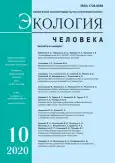Множественные сравнения в биомедицинских исследованиях: проблема и способы решения
- Авторы: Наркевич А.Н.1, Виноградов К.А.1, Гржибовский А.М.2,3,4,5
-
Учреждения:
- ФГБОУ ВО «Красноярский государственный медицинский университет им. проф. В. Ф. Войно-Ясенецкого»
- ФГБОУ ВО «Северный государственный медицинский университет»
- Западно-Казахстанский медицинский университет им. Марата Оспанова
- Казахский Национальный Университет им. аль-Фараби
- ФГАОУ ВО «Северо-Восточный федеральный университет им. М. К. Аммосова»
- Выпуск: Том 27, № 10 (2020)
- Страницы: 55-64
- Раздел: Статьи
- URL: https://journals.rcsi.science/1728-0869/article/view/47150
- DOI: https://doi.org/10.33396/1728-0869-2020-10-55-64
- ID: 47150
Цитировать
Полный текст
Аннотация
Полный текст
Открыть статью на сайте журналаОб авторах
Артём Николаевич Наркевич
ФГБОУ ВО «Красноярский государственный медицинский университет им. проф. В. Ф. Войно-Ясенецкого»
Email: narkevichart@gmail.com
кандидат медицинских наук, доцент, декан медико-психолого-фармацевтического факультета, заведующий кафедрой медицинской кибернетики и информатики, заведующий лабораторией медицинской кибернетики и управления в здравоохранении
Константин Анатольевич Виноградов
ФГБОУ ВО «Красноярский государственный медицинский университет им. проф. В. Ф. Войно-Ясенецкого»
Андрей Мечиславович Гржибовский
ФГБОУ ВО «Северный государственный медицинский университет»; Западно-Казахстанский медицинский университет им. Марата Оспанова; Казахский Национальный Университет им. аль-Фараби; ФГАОУ ВО «Северо-Восточный федеральный университет им. М. К. Аммосова»
Список литературы
- Буненков Н. С., Буненкова Г. Ф., Комок В. В., Гриненко О. А., Немков А. С. SAS Enterprise Guide 6.1 для врачей: сравнение групп // Медицинский академический журнал. 2019. Т. 19, № 4. С. 33-40. DOI: 10/17816/ MAJ17736
- Гржибовский А. М. Анализ трех и более независимых групп количественных данных // Экология человека. 2008. № 3. С. 50-58
- Гржибовский А. М. Сравнение трех и более независимых групп с использованием непараметрического критерия Краскела - Уоллиса в программе Stata // Экология человека. 2014. № 6. С. 55-58
- Гржибовский А. М., Иванов С. В., Горбатова М. А. Сравнение количественных данных трех и более независимых выборок с использованием программного обеспечения Statistica и SPSS: параметрические и непараметрические критерии // Наука и Здравоохранение. 2016. № 4. С. 5-37
- Гржибовский А. М., Иванов С. В., Горбатова М. А. Сравнение количественных данных трех и более парных выборок с использованием программного обеспечения Statistica и SPSS: параметрические и непараметрические критерии // Наука и Здравоохранение. 2016. № 5. С. 5-29
- Маркевич А. Н., Виноградов К. А. Настольная книга автора медицинской диссертации: пособие. М.: Инфра-М, 2019. 454 с
- Benjamini Y., Hochberg Y. Controlling the false discovery rate: a practical and powerful approach to multiple testing. Journal of the Royal Statistical Society: series B (Methodological). 1995, 57 (1 ), pp. 289-300. doi: 10.1111/j.2517-6161.1995.tb02031.x
- Bonferroni C. E., Teoria statistica delle classi e calcolo delle probability Pubblicazioni del R Istituto Superiore di Scienze Economiche e Commerciali di Firenze. 1936, 62 p.
- Che R., Jack J. R., Motsinger-Reif A. A., Brown C. C. An adaptive permutation approach for genome-wide association study: evaluation and recommendations for use. BioData Mining. 2014, 7, pp. 9. DOI: 10.1 186/1756-0381-7-9
- Dunnett C. W. A multiple comparison procedure for comparing several treatments with a control. Journal of the American Statistical Association. 1955, 50, pp. 1096-1121. doi: 10.1080/01621459.1955.10501294
- Foulkes A. C., Watson D. S., Griffiths C. E. M., Warren R. B., Huber W., Barnes M. R. Research Techniques Made Simple: Bioinformatics for Genome-Scale Biology. Journal of Investigative Dermatology. 2017, 137, pp. e163-e168. doi: 10.1016/j.jid.2017.07.095
- Gao X., Starmer J., Martin E. R. A multiple testing correction method for genetic association studies using correlated single nucleotide polymorphisms. Genetic Epidemiology. 2008, 32 (4), pp. 361-369. DOI: 10.1002/ gepi.20310
- Holland B. S., Copenhaver M. D. Improved Bonferroni-type multiple testing procedures. Psychological Bulletin. 1988, 104 (1), pp. 145-149. doi: 10.1037//0033-2909.104.1.145
- Holm S. A simple sequentially rejective multiple test procedure. Scandinavian Journal of Statistics. 1979, 6 (2), pp. 65-70.
- Johnson R. C., Nelson G. W, Troyer J. L., Lautenberger J. A., Kessing B. D. Accounting for multiple comparisons in a genome-wide association study (GWAS). BMC Genomics. 2010, 11, pp. 724. doi: 10.1186/1471-2164-1 1-724
- Keuls M. The use of the «studentized range» in connection with an analysis of variance. Euphytica. 1952, 1 (2), pp. 112-122. doi: 10.1007/bf01908269
- Moran M. Arguments for rejecting the sequential Bonferroni in ecological studies. Oikos. 2003, 100 (2), pp. 403-405. doi: 10.1034/j.1600-0706.2003.12010.x
- Newman D. The distribution of range in samples from a normal population, expressed in terms of an independent estimate of standard deviation. Biometrika. 1939, 31 (1), pp. 20-30. doi: 10.1093/biomet/31.1-2.20
- Rothman K. J. No Adjustments Are Needed for Multiple Comparisons. Epidemiology. 1990, 1 (1), pp. 43-46. doi: 10.1097/00001648-199001000-00010
- Seidler J., Vondracek J. I., Saxl I. The life and work of Zbynek Sidak (1933-1999). Applications of Mathematics. 2000, 45 (5), pp. 321. doi: 10.1023/A: 1022238410461. hdl:10338.dmlcz/134443
- Shaffer J. P. Multiple Hypothesis Testing. Annual Review of Psychology. 1995, 46 (1), pp. 561-584. doi: 10.1146/annurev.ps.46.020195.003021
- Sidak Z. K. Rectangular Confidence Regions for the Means of Multivariate Normal Distributions. Journal of the American Statistical Association. 1967, 62 (318), pp. 626633. doi: 10.1080/01621459.1967.10482935
Дополнительные файлы







